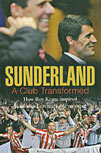 Sunderland: A Club Transformed
Sunderland: A Club Transformed
by Jonathan Wilson
Orion, £16.99
Reviewed by Ed Upright
From WSC 251 January 2008
The Irish Uprising: How Keano and the Mighty Quinn saved Sunderland
by Andy Dawson
Sportsbooks, £10.99
Reviewed by Ed Upright
From WSC 251 January 2008
Support for the Northern Ireland peace process seems to be gathering pace on Wearside – at least if you judge by name changes to some of Sunderland’s least welcoming pubs. One such hostelry, always known for the pro-Unionist nature of its clientele, is now named after Sunderland’s current manager, whose Irish national pride is well documented. This transformation is only one example of the way the explosion of interest since Roy Keane’s appointment has changed perceptions both inside and outside the region.
However, both Jonathan Wilson and Andy Dawson are too genuine and self-aware to be distracted by the mildly irritating “Keano” hyperbole. Though very different in scope and style, these books do an excellent job of putting the 2006-07 season in the context of the past, present and future of Sunderland AFC and, in Wilson’s case, the city itself.
The present is explained in detail and with humour. Last season was highly impressive, especially when reminded of the amount of work needed at its onset. As Dawson states, Keane instituted standards of preparation never before seen at Sunderland and had man-management skills to make this count. Wilson sees Keane’s impact not as a great upheaval but as the combination of “a thousand little things”. Dawson’s summary of the season in the style of Steve Bruce’s little-known football novels is a highlight, alongside Wilson’s image of Stan Varga defending like a Tolkien ent before slinging a hobbit, “or Ross Wallace”, over his shoulder. Both avoid the tedium of endless match reports through well chosen Keane quotes.
There are greatly differing approaches to the club’s freakish and torrid recent history. While Dawson’s book has a local focus and football basis, for Wilson, who no longer lives in the north-east, his football past is inextricably linked with his personal relationship to the fabric and history of the city. He references Bryan Talbot’s excellent Alice in Sunderland and, like this graphic novel, Wilson’s book suggests a new and long overdue cultural self-confidence is abroad. His feelings on “exile” and nostalgia for a “mythic” north-east are beautifully observed, the explanations of social and historical peculiarities of the area ring true and the memories and observations that a visit creates are evocative and heartfelt. Wilson’s pain at the post-war neglect of both town and club is clear and justified.
Dawson concentrates on the football. His account of 2006-07 is interspersed with the story of the Stadium of Light’s first decade. An era of extremes – the missed opportunity of two seventh-placed finishes before Peter Reid’s luck ran out, to the two seasons of abject, record-breaking failure. Experiencing this again it is difficult not to wince, but Dawson explains it all calmly and wisely, expressing perfectly the sense of betrayal in the stands, the tainted relationship and broken promises between club and fans – damage that is only now beginning to mend.
And it is this direct and acute comparison between the present of the club and its recent history that leads us to conclusions on its future. Perhaps understandably in this context, both books reveal an infectious and profound sense of long-term hope. There is a new sense of professionalism from top to bottom and the new regime seems dignified and progressive. Optimism is not unfounded.